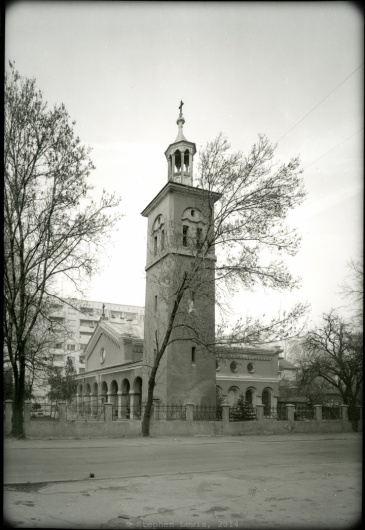The Church of St. James the Martyr, Poduyane Quarter, Sofia, Bulgaria: A Careless Assumption, a Careless Bombardment, and the Benefits of a Once-Strong Back

Church of St. James the Martyr, Poduyane Quarter, Sofia, Bulgaria, late-1990s. Note the concrete panel block apartment house in the background, a late-Soviet-era solution to urban housing shortages and a parallel to the red-brick “projects” that rose to pockmark US urban landscapes during the 1940s-1960s. (Toyo field camera, 6x9cm back, 55mm Rodenstock lens, b/w negative film (probably 400ASA), scan of print). Click on image to enlarge.
The photo above shows a curiously Italianate-looking church in Poduyane, a suburb of Sofia, Bulgaria, annexed to the city late in the 19th century.
A Careless Assumption
When I took the photo, fifteen or so years ago, I assumed that the church dated from the turn of the nineteenth century to the twentieth, a time when the newly-formed nation-state of Bulgaria was inventing “national styles” of its own. It was not until last winter that I returned to the church to take a closer look. My initial assumption turned out to be far from correct. According to a dedicatory plaque in the vestibule of the church, the edifice was built in the 1950s on the site of a church of the same name that had been destroyed by bombing during the Second World War. The plaque in the present-day church, however, neglected to say why the site had been bombed or by whom. During the 1930s and up to 1944, when it switched sides following occupation by the Soviet Union, Bulgaria had been an enthusiastic ally of Nazi Germany. The country gave the Nazis access to its gold reserves and an overland route through which to solidify the occupation of Greece and, with it, an opening to the Mediterranean — this in return for support of Bulgaria’s irredentist land-grabs at the expenses of Greece, Romania, and that part of Yugoslavia that is now Macedonia. For good measure, Bulgaria also glibly adopted German “racial” policies and passed and enforced a “Law for the Protection of the Nation” that was even more stringent than the Nazi’s own anti-Jewish Nuremberg Laws.
A Careless Bombardment
Poduyane, as the etymology of its name suggests, is a high, plateau-like area. Tracks leading from Sofia’s main rail-head eastward towards Thrace and on to Istanbul beyond have, since the rise of the railroad, traced the borderline between Poduyane and Sofia proper. My assumption is that one or more planes tasked with destroying the rail-head released their bombs moments too soon, flattening the original Church of St. James the Martyr and its surroundings in the process. But, as shown above, my assumptions are, as often as not, equally off-target.
Photographic Footnote: A Once-Strong Back
Years ago, when my back was stronger and time seemed more plentiful, I regularly took to the streets with a metal tripod slung over one shoulder and a heavy bag containing field camera, lenses, and roll-film backs over the other. The photo above was taken with such a rig on a freezing mid-winter Sunday. Technical limitations of my field camera, together with the effects of the cold on my un-gloved fingertips, led me to adjust the camera less rigorously than I might have done otherwise … thus the oval-shaped “yaw” distortion deforming the crow’s nest atop the church’s bell-tower.